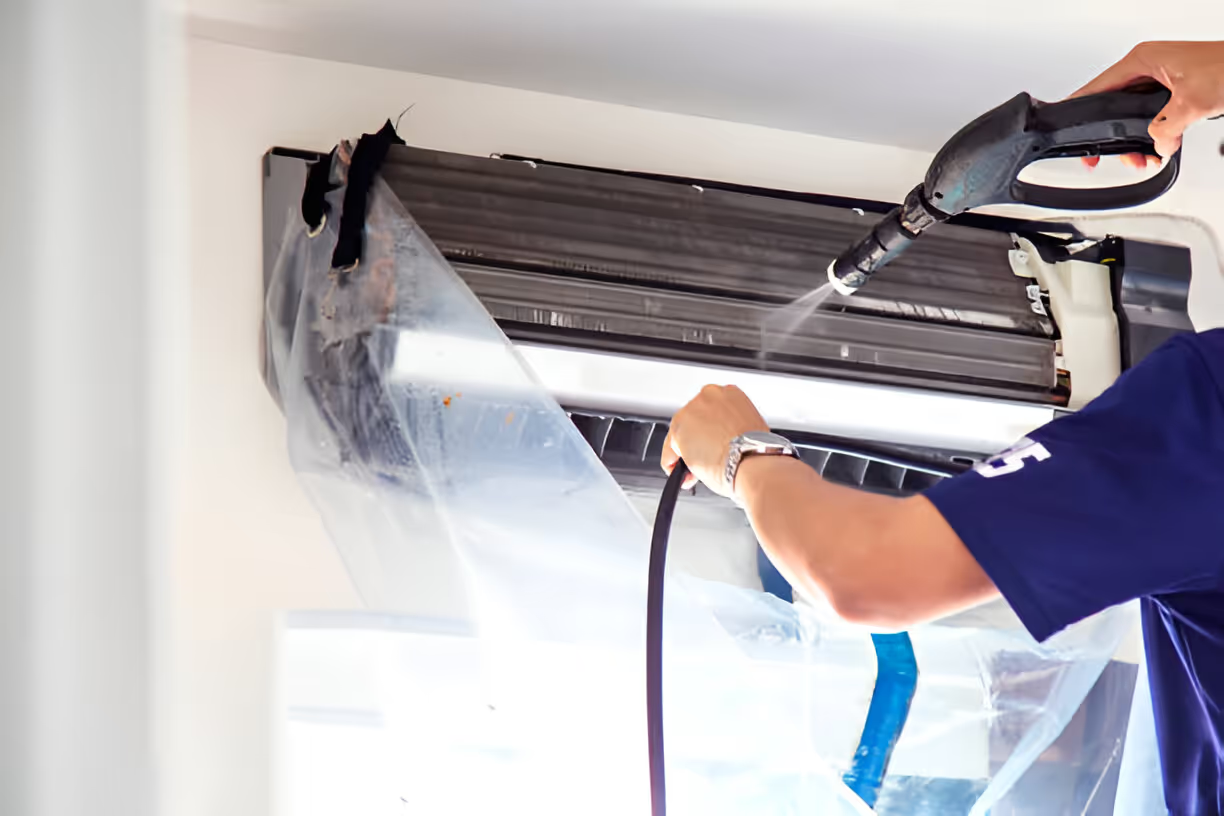Ductless Maintenance in Tempe, AZ
Ductless maintenance service in Tempe, AZ ensures efficient performance and longer equipment life for homes. Schedule a tune-up today.
Ductless Maintenance in Tempe, AZ
Ductless maintenance in Tempe, AZ is a crucial investment for homeowners and businesses that rely on ductless mini-split systems to stay comfortable through hot, dusty summers and unpredictable monsoon seasons. Regular preventative maintenance keeps your system running efficiently, prevents mid-summer breakdowns, and protects indoor air quality from Arizona dust, pollen, and debris. For Tempe properties where cooling runs heavily from spring through fall, well-timed maintenance reduces energy costs and extends system life.

Common ductless maintenance issues in Tempe, AZ
Tempe’s climate and local conditions create a handful of predictable problems for ductless systems:
- Clogged or dirty filters from frequent dust and pollen, reducing airflow and efficiency.
- Dirty evaporator and condenser coils, leading to reduced heat transfer and higher run times.
- Refrigerant leaks or low charge detected after long, heavy-use seasons.
- Malfunctioning controls or sensors affected by dust, humidity changes, or power events.
- Clogged condensate drains or pan algae buildup from humidity spikes during monsoon weather.
- Worn electrical components (capacitors, relays) from constant cycling during peak heat.
- Outdoor unit obstructions (debris, landscaping growth) limiting airflow.
Understanding these early helps prioritize the right tune-ups and repairs for Tempe homes and small businesses.
What a seasonal tune-up includes
A professional seasonal tune-up for a ductless mini-split typically covers these checkpoints and services:
- Visual inspection of indoor heads and outdoor condenser for damage, debris, and obstructions.
- Filter cleaning or replacement and inspection of filter rails and mounting.
- Coil cleaning for evaporator and condenser coils to restore heat transfer efficiency.
- Refrigerant pressure check and leak inspection to confirm correct charge and system integrity.
- Airflow and static pressure checks across the indoor unit to verify proper circulation.
- Thermostat, control board, and sensor calibration for accurate temperature control.
- Condensate drain inspection and clearing to prevent water damage and mold growth.
- Electrical safety inspection: tightening connections, checking capacitors, motors, and fuses.
- Performance test: measuring temperature split, runtime performance, and start/stop behavior.
These steps catch small issues before they become emergency repairs and help keep efficiency high during Tempe’s extended cooling season.
Diagnostic approach and common repairs explained
When technicians diagnose ductless systems, they follow a methodical process to isolate root causes rather than treating symptoms:
- System history and symptom review: when problems began, recent weather events, and usage patterns.
- Operational testing: observing start-up, run cycles, noise, and temperature differentials.
- Refrigerant testing: measuring pressures and temperatures to identify undercharge or leaks.
- Electrical diagnostics: testing capacitors, contactors, fan motors, and control voltages.
- Indoor head inspection: checking blower wheel, drain pan, and sensor placement.
Common repairs after diagnostics include refrigerant leak repair and recharge, coil cleaning or fin straightening, fan motor or capacitor replacement, control board or sensor replacement, and condensate drain repair. Technicians balance repair vs. replacement decisions based on system age, cost-effectiveness, and long-term reliability goals.
Benefits of regular ductless system maintenance
Regular maintenance delivers tangible benefits for Tempe properties where cooling is mission critical:
- Improved efficiency: clean coils and correct refrigerant levels let the system cool with less energy, lowering electric bills during high-demand months.
- Longer equipment life: reducing strain on compressors and fans prevents premature failure and postpones replacement.
- Fewer breakdowns: proactive component checks identify worn parts before they cause system failures on the hottest days.
- Better indoor air quality: clean filters and coils reduce dust, pollen, and microbial growth inside indoor units.
- Warranty protection: many manufacturers require documented maintenance to keep warranty coverage valid.
- Predictable budgeting: scheduled maintenance reduces the likelihood of costly emergency repairs.
Maintenance agreements and what to expect
Maintenance agreements for ductless systems usually bundle seasonal tune-ups with perks that make upkeep easier and more reliable:
- Scheduled service visits timed for pre-summer and post-monsoon inspections to prepare systems for peak use.
- Priority scheduling during high-demand periods and documented service history for warranty and resale value.
- Options for single-system or multi-head coverage, tailored to homes with several indoor units.
- Flexible service intervals based on usage and environmental factors (more frequent service for dusty or high-use systems).
- Clear records of parts replaced, refrigerant changes, and performance metrics.
A consistent maintenance plan is especially valuable in Tempe, where long cooling seasons and airborne dust increase wear on mini-splits.
Local recommendations for Tempe homeowners
To get the most from ductless maintenance in Tempe, consider these location-specific tips:
- Schedule at least two professional tune-ups per year: one in spring before heavy cooling begins, and one in late summer or early fall after monsoon storms and high pollen events.
- Clean or replace washable filters every 1–3 months depending on dust levels and occupancy.
- Keep outdoor units clear of landscaping, gravel blow-in, and patio debris to maintain proper airflow.
- Inspect indoor heads and drain lines after strong storms; monsoon dust and wind can clog drains and introduce debris.
- For homes near busy roads or construction, increase inspection frequency because additional dust accelerates coil fouling.
Quick maintenance tips you can do between professional visits
- Rinse washable filters monthly and let them dry completely before reinstalling.
- Keep a 2–3 foot clearance around outdoor condensers and brush away accumulated debris.
- Wipe indoor unit louvers and visible coils gently with a soft brush to reduce surface dust.
- Monitor running performance: unusual noises, reduced cooling, or frequent cycling indicate the need for professional inspection.
Regular ductless maintenance in Tempe, AZ protects system efficiency, extends equipment life, and keeps indoor comfort consistent through extreme heat and seasonal storms. A well-maintained ductless mini-split provides reliable cooling while minimizing energy use and unexpected repair costs.






